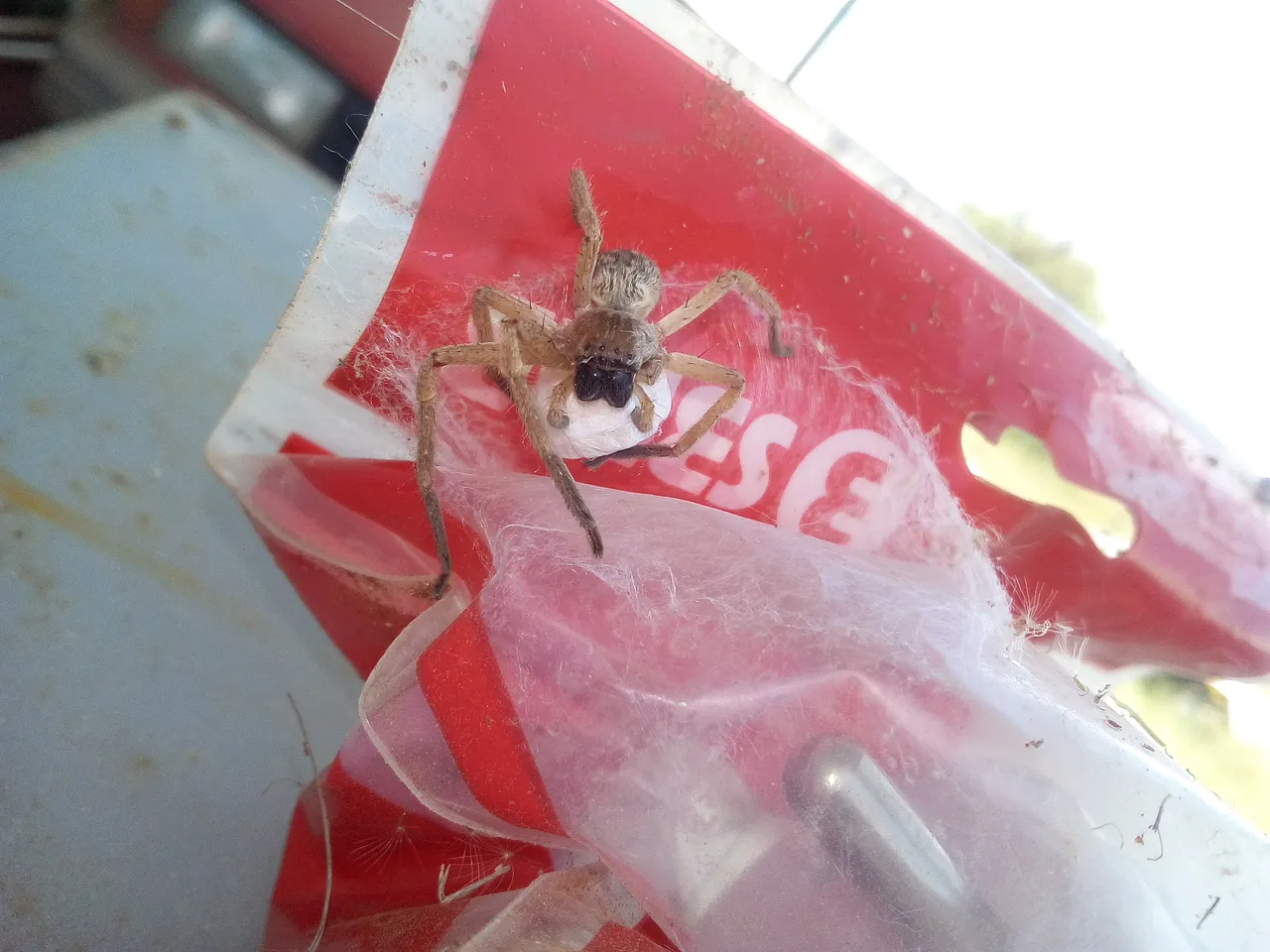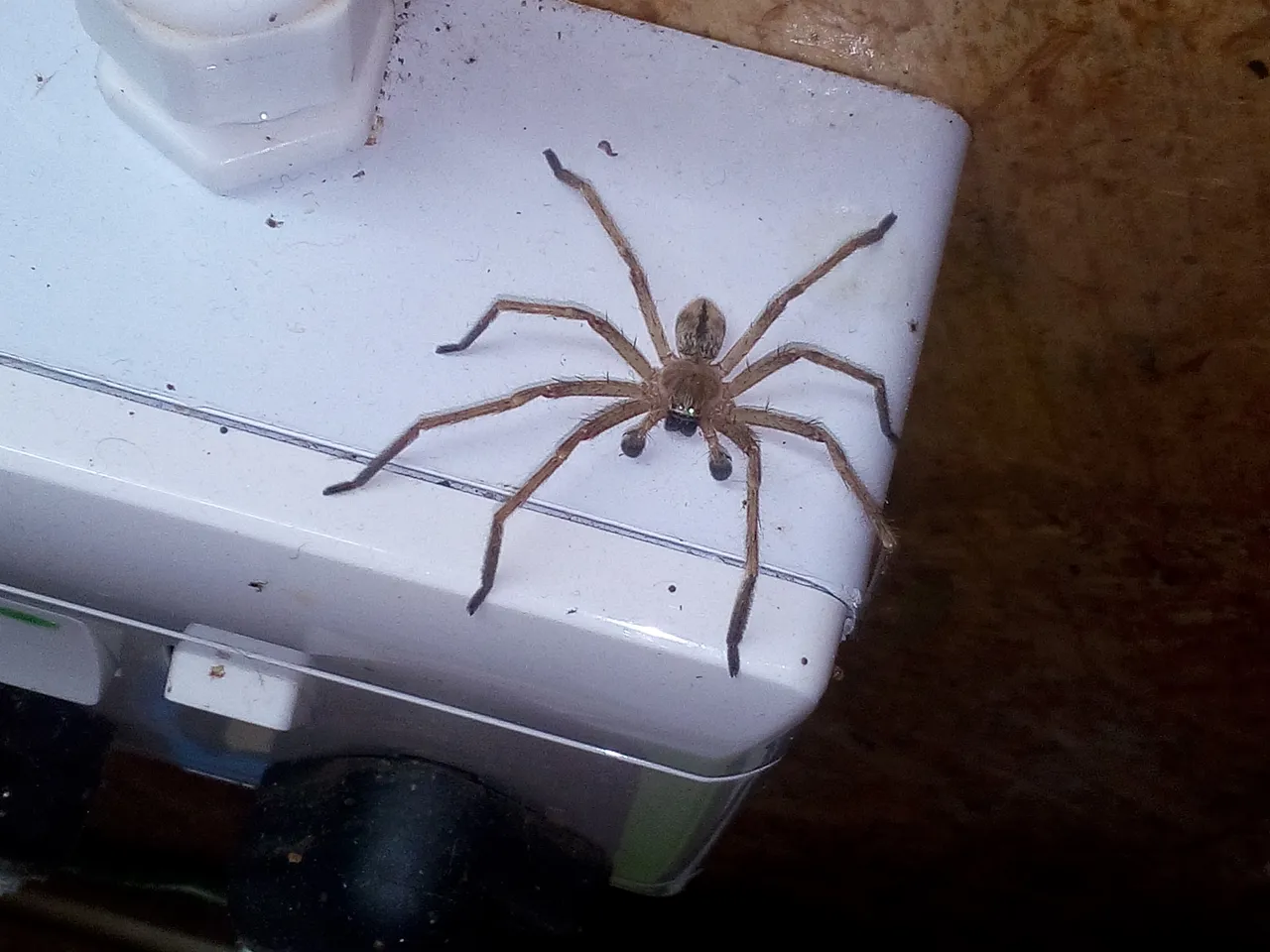Hi, Hive!
Another week, another spider. And this time, it's all about a teddy-bear of a spider. The huntsman. This particular huntsman is in the genus Olios, which tend to be grass huntsman spiders, ranging in colours from green, white, orange, and yellowish brown.
I call huntsman teddy-bears because of how gentle and shy they are. They also sort of look like them, if teddies were spiders that is. Huntsman are medically insignificant spiders though they can pack quite a punch with their bite. Especially in the larger huntsman spiders that have long fangs attached to strong chelicerae.
• OLIOS SHERWOODI •

I came across this female Olios huntsman spider while gathering up some of our building materials, not realising she's made her nest between the folds of the plastic. I tore it open unwittingly when I pulled on it, and the female hurried out, but didn't run away or jump off the packet.
I'd been seeing a few males of this species coming into the house and chilling on the cornices for a day or two before disappearing again so I was ecstatic to finally find a female. She wasn't so happy to see me, however.
• GENUS •

Olios huntsman spiders look a lot like their cousins, the rain spider (Palystes sp.), but they're much smaller in size and leg span. They're identifiable by their wide carapace and two neat rows of 4 eyes, of which the middle front ones are a little larger than the other eyes.
O. sherwoodi, apart from other Olios species, is identified by the yellowish brown colour with darker metatarsus and tarsus, dark chelicerae, as well as by the pattern on the dorsal abdomen. So far, only the male of this species has been described though there are images of the female and she has been acknowledged as being O. sherwoodi.
• DESCRIPTION •

Taxon:
- Class: Arachnida
- Order: Araneae
- Infra-Order: Araneamorph (true spiders)
- Family: Sparassidae
- Genus: Olios
- Species: O. sherwoodi
Female
Around 15mm in body length. Leg span of approximately 33mm diagonally.
Cephalothorax:
Wide, flat, mottled light brown carapace, dark around eyes and chelicerae. 2 neat rows of 4 eyes of which anterior median are larger.
Abdomen:
Egg-shaped abdomen with sharp posterior, light brown and mottled with darker chevron-like pattern tapering down dorsal centre.
Legs:
Pale, almost yellowish brown legs with darker metatarsus and tarsus. Prominent dark setae on femur and tibia. Second pair are slightly longer than first pair and the third leg pair is the shortest.
Male
About 9mm in body length. Leg span of approximately 23mm diagonally.
Male physical characteristics as in female but with dark, enlarged tarsus on pedipalps. Legs are thinner and longer, and the pattern on the dorsal abdomen is darker than in the female.
• ABOUT THE GENUS •

Olios is a diverse genus of huntsman spiders, and was often used as a sort of dumpster for newly described species to just place them 1. This is likely why the spiders in the Olios genus vary so greatly with their appearances. Also why this is the largest of the huntsman genera.
While not large, they're quite adept at hunting and aren't skittish, though they'll run away if prodded or disturbed. Like with many spiders, Olios huntsman females tend to be larger than their male counterparts.
Olios spiders will make a silk retreat, usually between leaves or grasses, but sometimes also in the folds of artificial materials like cloth and plastic. The retreats are large cocoon-like structures and mainly seen housing females with eggs. Males tend to wander when mature, in search of females.
• NOTES •
The female O. sherwoodi I distrurbed when I grabbed the plug packet on which she had made her nest, was very attentive and protective of her egg sac. At first, she tried to ward me away from her egg sac by running quickly a little away and back again, then by making a go at my fingers if I came too close.
She must have realised I was too large an animal and wasn't being frightened off, so she gathered her egg sac up using her pedipalps and chelicerae to grip it, before she hurried away from me into the bushes. She kept one leg under her egg sac the whole time, which was impressive as far as protecting egg sacs go.
At a point, she dropped her egg sac, either deliberately or accidentally, and skittered away before returning to pick it up again. I'm not sure why she abandoned it only to reclaim it, but I guess it was to make sure her new nest location would be secure first by leaving the egg sac relatively safe in a spot?

